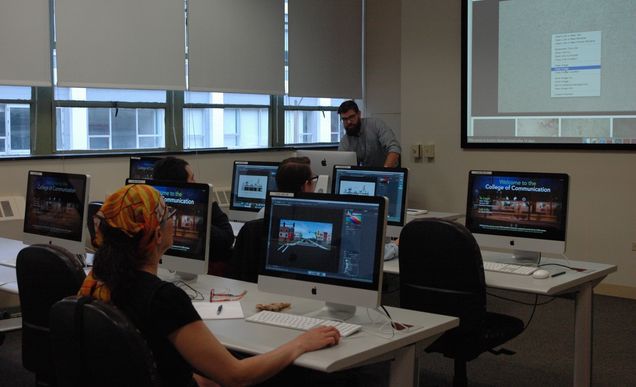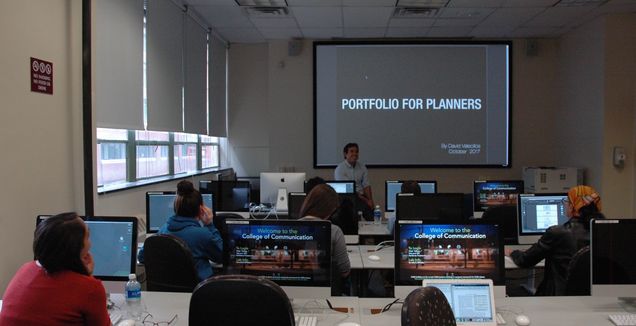#BUcityplanning Students Increase their Marketability at Digital Design Skills and Portfolios for Planners Workshop

On October 14th from 10am to 2:30pm, in COM 206, the City Planning and Urban Affairs Program hosted a Digital Design Skills and Portfolios for Planners Workshop for #BUcityplanning students and Architectural Studies students. Brian Creamer started the morning with a session on digital design to help students acquire highly sought-after skills in the Adobe Create Suite. An MCP 2015 graduate, Mr. Creamer has a background in landscape and works at Nitsch Engineering for campus planning, and his current project is stormwater management for Princeton. Mr. Creamer also has a bachelors degree in landscape architecture from The Pennsylvania State University and a Master in City Planning from Boston University.
As the industry standard for design and planning, most designers use InDesign, PhotoShop, Illustrator, and Dreamweaver for custom website design. This software is useful because they have robust

tools. With major projects such as Tufts trying to digitize campus plans (and BU with a similar plan), Photoshop can be useful for building visualizations to help with community feedback. In conjunction with SketchUp 3D Warehouse, which is an Adobe plugin and provides stock buildings and objects such as trees and people, streets, sidewalks and buildings can be visualized in the software. Textures can be added and deleted, color can be adjusted and textures added with the software as well.
With Illustrator, users can import Shapefile for conceptual layout of roads and for building integration. To follow up with InDesign, everything should be bounded by a box, the template should have pages facing each other to read like a book in a column, and guides should be put on a layer and locked. All these steps can be reviewed online at Planetizen Courses.
#BUcityplanning courses, such as UA 613 Urban Design and Development, UA 654 GIS and Spatial Analysis, and UA 805 Urban Studies Capstone emphasize digital design skills and offer degree and non-degree seeking students an opportunity to enhance digital design skills and develop striking presentation materials.
Following this session, from 12pm to 1pm, students, faculty, and the presenters broke for lunch where they introduced themselves, detailing their backgrounds, interests, and future plans, as well as had an informal discussion on the importance developing digital design skills and having a strong portfolio to give future planners an edge in the competitive job market.
Following lunch, from noon to 2:30pm, David Valecillos held a Portfolios for Planners session. Mr. Valecillo studied Civil Engineering at the University of South Carolina and is in real estate development. While pursuing his Master in City Planning at BU, Mr. Valecillos worked as a research assistant at the BU Sustainable Neighborhood Lab, which is now a part of the Pardee Center. He is currently working on a redevelopment of 100 units in Salem.

Mr. Valecillo explained the importance of a portfolio as a link between you and the employers, clients, or being considered for a grant. A portfolio should include past projects, practice areas, as well as values and mission. Additionally, work goals should be elaborated on, specifying for example interest in real estate, community planning, or policy.
Using Google Advanced Search, students can look up how competitors are building and presenting their research and use this as a frame of reference. Otherwise, key elements of a portfolio include not only the general content, but also the formatting and layout. Students were advised to choose around 3 to 5 colors (with dark blue, black and white as an example for a real estate or investment firm), as well as font styles such as Helvetica or Times New Roman. The hierarchy of the portfolio can be highlighted using color and indentations from the margin for emphasis. The paper size, orientation or flow of the portfolio, as well as the materials also play a certain part in the overall product.
Article by Meaghan T’ao, CAS ’18
Poster by Jiayu Zhou, CAS ’19
